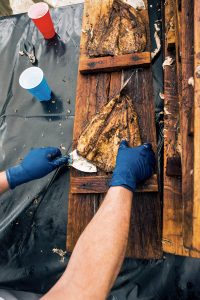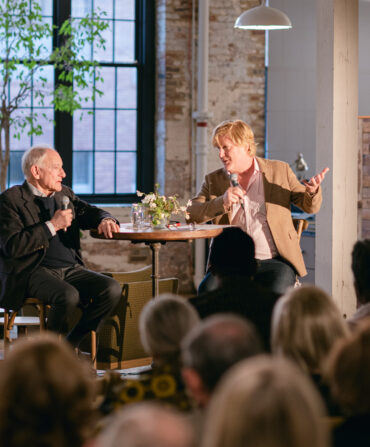Arts & Culture
Fishing for Votes
Every April in Tidewater Virginia, politicians and ordinary folks gather to celebrate spring, smoked shad, and the age-old practice of civic discourse. Welcome to the Wakefield Shad Planking

Photo: Randy Harris
He told me to “get down in there amongst ’em,” and he should know. The old man was talking about the cypress knees and one ancient cypress tree in particular, between the Nottoway River boat ramp and the tumbled-down Southside Railroad trestle maybe fifty yards downstream. He’d fished there for years, he said. It was a twenty-five-minute drive, but that was the spot. Something about it drew the shad.
At the time we were standing in front of the largest cooking fire I’d ever seen, a 120-foot-long pyre of seasoned oak that had burned down to coals at the Wakefield Sportsmen’s Club, in Wakefield, Virginia. The Wakefield Shad Planking was nearing its seventh decade, and this mash-up of political rally and community fish feed remains a don’t-miss event in southeastern Virginia. Around the fire, 160 tall wooden planks stood like tombstones. Two American shad, butterflied as if in supplication, were nailed to each board. They glistened in the flames, rendered fat dripping down the blackened wood. It takes about six hours to plank a shad, and by the time these were ready, the politicians would be glad-handing the crowds at the Sportsmen’s Club. The tables and booths were already going up in the shade of tall pines: the Western Tidewater Young Republicans, the Prince George Electric Cooperative, a group lobbying for less restrictive marijuana laws. Someone sound-checked the stage audio. Someone else swept off the flatbed trailers that would serve as picnic tables for hundreds of shad eaters.
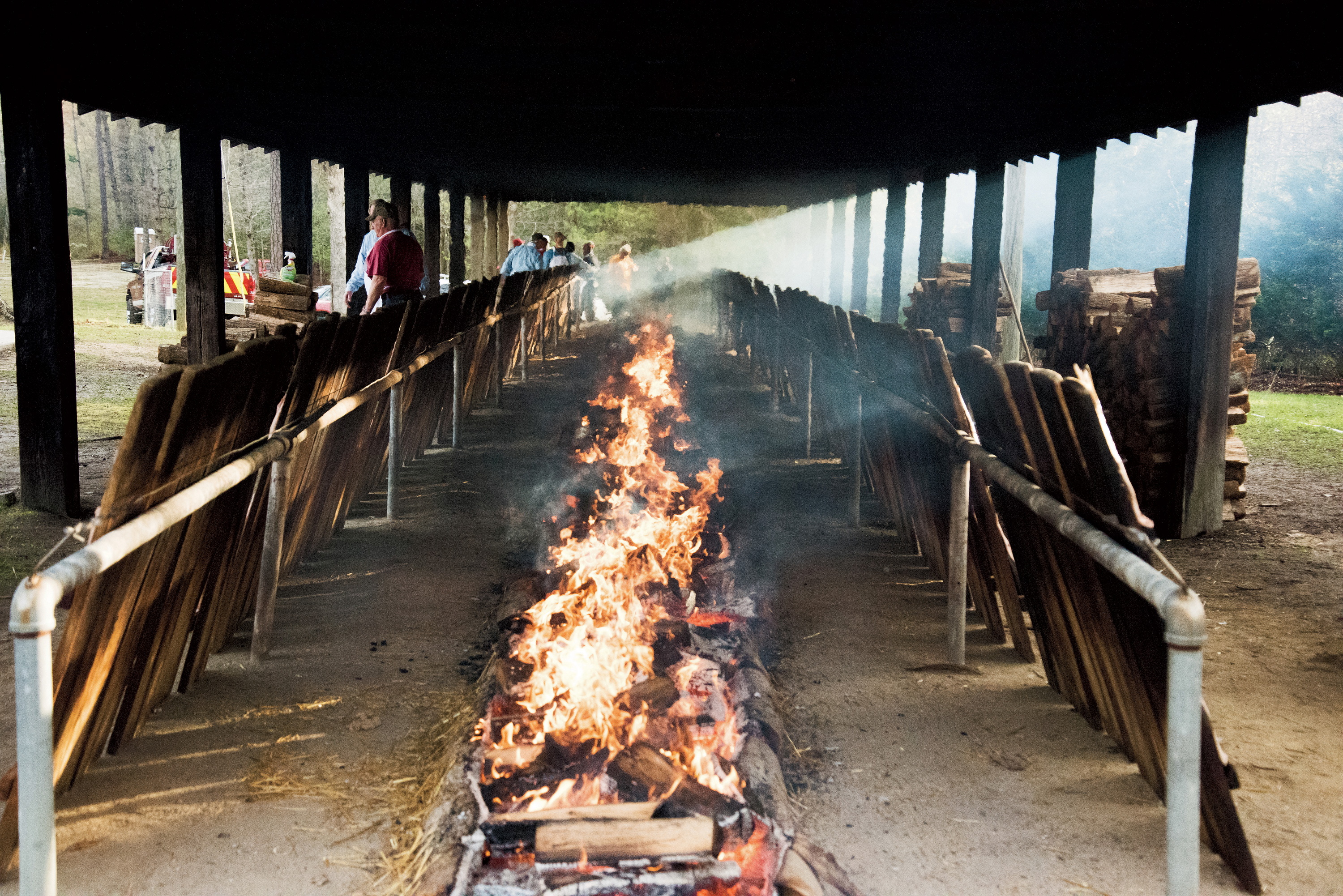
Photo: Randy Harris
The Firing Line
The fire is lit before dawn and burns for the six hours it takes to plank a shad.
But all that was to come. Six hours of downtime, I figured, should be time enough to catch a few of the fish myself.
I found the old man’s spot easily enough. The Nottoway River carves a gentle curve to the east, with a high bluff on river right, and the tannin-stained water swirled in paisleys of current around the cypress knees. Between the cypress and shagbark hickory trees there was a worn piece of muddy ground, and I knew in an instant it was the precise location the old man mentioned. I cast quickly and without thinking and I wasn’t really ready, but on that very first cast I hooked an American shad. It was silvery and shaped like a wedge, and it sounded deeply and used the river current to double the fight. I didn’t get another hit for forty-five minutes, but I wasn’t terribly concerned. For once, I knew with certainty where plenty of fish were waiting.
The Wakefield Shad Planking’s roots reach back to the early 1930s, when a group of men gathered to cook shad on wooden planks along the James River in Isle of Wight County. Even then, the informal event was an amalgam of cultural preservation and politics: Virginia Indians had planked shad for hundreds of years, and Virginians were known for their affinity for political sparring. The Ruritan Club took over the event in 1949 and moved it to Wakefield, where it has remained ever since, although it has changed dramatically in size and character. During presidential and senatorial election years, the crowd can swell to better than two thousand. Harry Byrd, Sr., Harry Byrd, Jr., John Warner, and George Allen have stumped at the event. Whereas once it was a whites-only, male-only, heavy-drinking gathering, it now draws a cross section of the Southside Virginia community. Women and African Americans first forayed to the planking in the 1970s. Public drunkenness is frowned upon. And while it was once a largely Democratic affair, the Shad Planking these days reflects the Republican tenor of southeastern Virginia.
But little has changed about the menu. American shad figure deeply in Southern history, although many Southerners today know little about them. Native to Atlantic-slope rivers from Labrador to Florida, shad live in the open ocean as adults, then migrate up coastal rivers, in the manner of salmon, to spawn. Before dams walled off the migrations, shad numbers were bewildering—the fish were so plentiful that Native Americans and colonists used them for fertilizer. In 1896 the American shad harvest in North Carolina’s Albemarle Sound, where men and mules hauled 10,000-foot-long seines, peaked at nearly 9 million pounds of fish. In Virginia, commercial landings of American shad regularly topped 10 million pounds. There are still remnants of the giant wooden “shad walks” along South Carolina’s Pee Dee River, where laborers worked the nets from shore.
Photo: Randy Harris
Crowds gather beneath the trees.
1 of 4
Photo: Randy Harris
Wetting a line in the James River.
2 of 4
Photo: Randy Harris
a freshly caught American shad.
3 of 4
Photo: Randy Harris
Earnest Crockett with butterflied shad.
4 of 4
Such an accessible and inexpensive food source put shad on the table of Southern farm families for months out of the year. Born in Shadwell, Virginia, Thomas Jefferson netted for shad as a child. George Washington ran a commercial shad operation, and shad helped keep his Continental troops alive after that bitter Valley Forge winter. The fish fed the growing number of slaves across the South. And for decades after the turn of the twentieth century, rural Southerners flocked to shad “plankings” or community shad feeds as they do to pig pickin’s today.
But American shad numbers have gone off a cliff in the last few decades. The Susquehanna River used to see millions of spawning American shad. In 2014, only eight fish made it past the four dams that clot the waterway. The story isn’t quite so dire in the James, the Rappahannock, the Roanoke, and the Pee Dee, where fish populations are high enough to pull in recreational anglers. But despite millions of dollars spent on shad stocking and restoration efforts in Atlantic states, American shad populations remain a thin shadow of their former selves. There are bright spots: Between 2000 and 2014, American shad abundance in the Chesapeake Bay rose dramatically, with the Potomac and Rappahannock Rivers posting high gains. But the numbers still pale in comparison to historic highs. “From a recreational fishing perspective, we are sustaining shad populations in the Chesapeake Bay drainage,” says Eric Brittle, a fisheries biologist with the Virginia Department of Game & Fish. “The populations are low, but stable.” A commercial moratorium on shad harvest in Virginia actually means festival organizers have to get the fish from neighboring North Carolina.
It all conspires to give the Wakefield Shad Planking an undercurrent of anachronism, but it’s a vibe equally yoked to the fervent desire to keep the tradition alive. American shad might be on the ropes, and political discourse might be more fractured than ever, but for a single day in late April every year, the fish provide a meeting place down in the Tidewater where salt meets fresh. And the right meets the left.
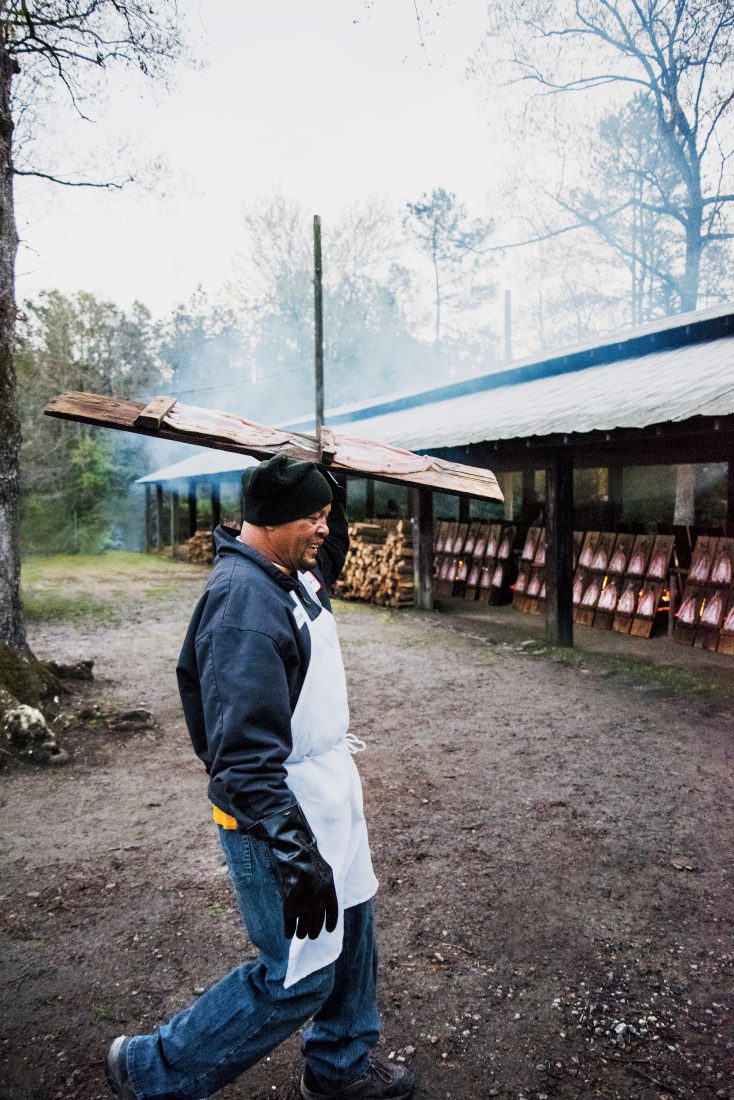
Photo: Randy Harris
Walking The Plank
Earnest Crockett carries fish to the fire.
By the time I drive back to Wakefield, campaign signs line the blacktop for hundreds of yards outside the Sportsmen’s Club. It’s impressive, and it hints at the event’s political clout. During presidential and congressional election years, the “sign war” creates a thicket of placards that presses in on the road for miles. It’s not uncommon for political teams to sneak in under the cover of darkness, moving their signs in front of opponents’ signs and jockeying for position at certain curves and intersections. “It can get kind of ridiculous,” says a grinning Brittle, who happens to be the chair of the Wakefield Shad Planking this year.
Still, modern life isn’t making things easy on a community shad planking. There’s growing competition from oyster roasts and music festivals. The burgeoning craft beer, wine, and farm-to-table scenes crowd the calendar. “Seems like there’s another festival every weekend,” Brittle says. “That doesn’t help.” And social-media-savvy politicians have their own concerns about attending any large event that involves beer trucks and bourbon tastings and a smattering of booths from various political movements. “Somebody posts a picture of the governor walking past a liquor booth and the next thing on the news is a story about the governor getting drunk,” says one Ruritan Club member, carrying a log toward the fire.
I didn’t see any examples of such chicanery. A lot of folks were too busy working. It takes at least sixty volunteers to run the Wakefield Shad Planking. There are separate committees to oversee the fire, the nailing down of the fish on the planks, the basting sauce, the plate preparation. Under a shelter two men wield cleavers: There’s a single chop to remove the tail, and three chops to quarter the rest of the fish. Each plate was heaped with planked shad, baked beans, slaw, and pickles. Fifteen Ruritan volunteers manned the serving line while another dozen ferried fish from the fire, balancing the hot oak planks with heavily gloved hands.
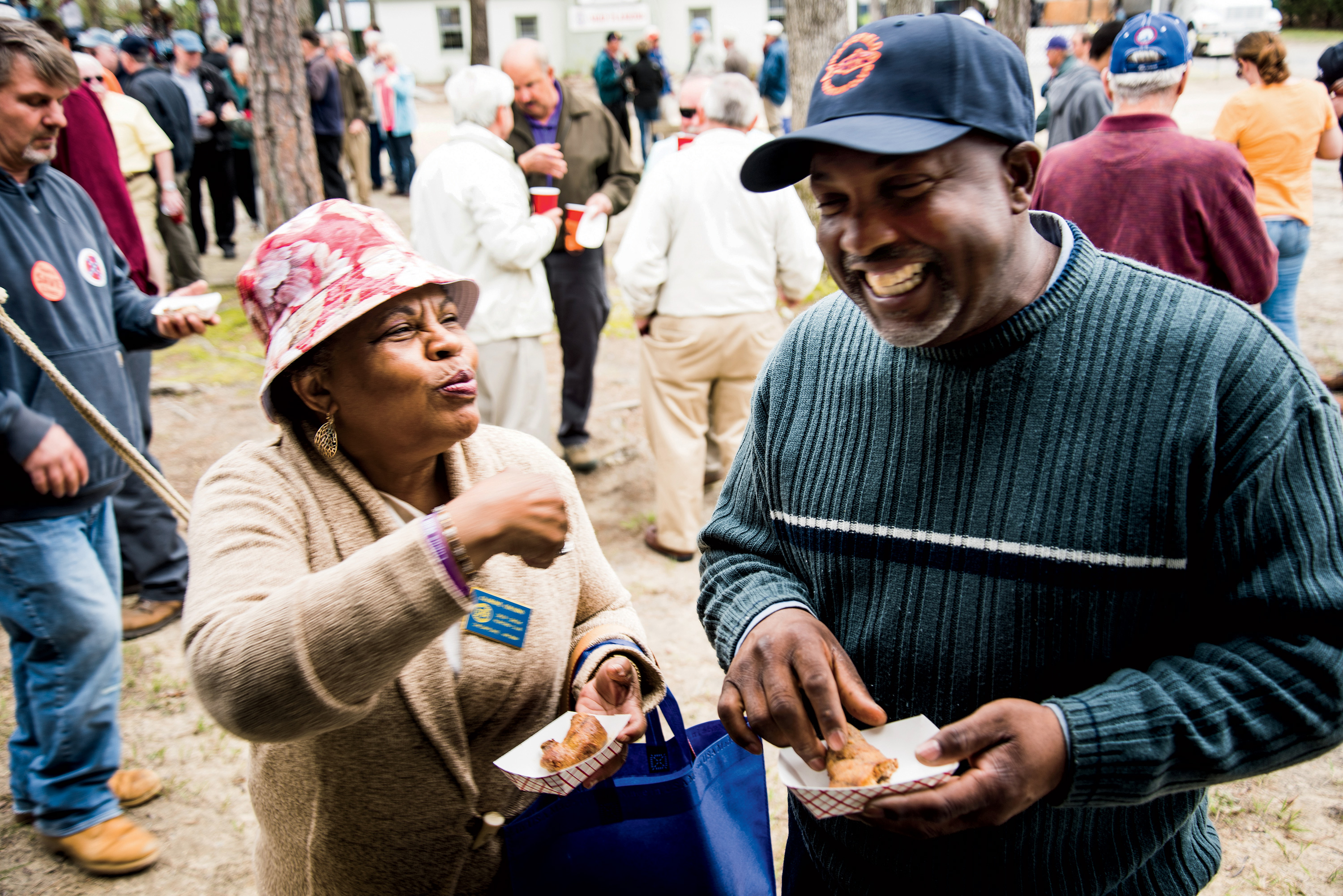
Photo: Randy Harris
Attendees enjoy the food and fellowship.
Standing around flatbed trailers as makeshift dining tables were hundreds of shad eaters, in business suits and skirts, Carhartts and khakis. Guys in T-shirts emblazoned with pipe shop logos talked about how many turkeys they heard that morning, trading stories about deer pictures from their trail cameras with men in starched shirts and neckties.
I sidled up to one older gentleman in chinos pressed with a pleat, cowboy boots, and a turquoise bolo tie. Elwood Floyd Yates, Jr., eighty-five, is from Powhatan County, some thirty miles west of Richmond. His father, Elwood Floyd Yates, Sr., served six sessions in the Virginia General Assembly, and attended every Wakefield Shad Planking from 1949 until he died at age 107 in 2010. Yates attended his first Shad Planking with his father when he was either twenty-one or twenty-two. “I’m not sure which,” he told me. “But I’m sure I haven’t missed a single one since.”
Yates remembered setting shad nets “on the Chick,” which is the Chickahominy River, “back when if we heard an outboard motor we’d run to the river to see what it was.” Now, he lamented, you couldn’t float a net in the Chickahominy for all the boats in the river, “but never mind,” he figured. “You can’t net for shad these days anyway.”
When he found out I’d never eaten fried American shad roe, Yates lit up. If planked shad is an acquired taste, shad roe is the equivalent of taking out a mortgage. It’s alternately described as liver-like, grainy, and sublime, a love-it-or-throw-it-on-the-ground culinary experience. “I want to be there to see your first bite of shad roe,” he said. “Come on here. We’re a-going right now.”
We walked over to the roe tent where the egg sacs were lined up like sushi. The queue was fifty people deep. When it was my turn, I held my cupped hands out as if accepting Communion. I was given twinned sacs of roe in a white paper french fry tray, red-pink like salmon, rolled in seafood breader and deep-fried. I took a bite. The roe sacs firmed up in the heat of the hot fat, like a hush puppy flavored with a delicate brine, a mouthful of the Tidewater if ever such a thing existed.
Yates watched my expression. “Uh-huh. That’s what I told you,” he said. “You won’t ever forget that.”
By 4:00 p.m. the Shad Planking was bumping, and from the roe tent I made my way toward the main stage, past the booths with the free hats that push for offshore drilling in Virginia, past the Libertarian candidate touting his all-electronic, paper-free campaign, past the supporters of Confederate History Month and the tailgates groaning with old soldiers, their caps sporting Purple Hearts and service units.
Up on the stage, John H. Hager was finishing his speech, and I caught him before he could fill a plate with planked shad. Hager is a Republican stalwart who served as Virginia’s lieutenant governor from 1998 to 2002. He went to his first Wakefield Shad Planking thirty-six years ago.
“There is tremendous history here,” he said, with a politician’s ease, one eye on me and one on whoever else might be waiting for a word. “The Shad Planking is a seasonal rite of spring, but in the political realm, as well. Folks are coming out of their winter mode, ready to get back and get involved. It’s a time to reach back to your roots and foundations, whether from a political perspective or as a community.”
What he was trying to say is that it was time to get down in there amongst ’em.


